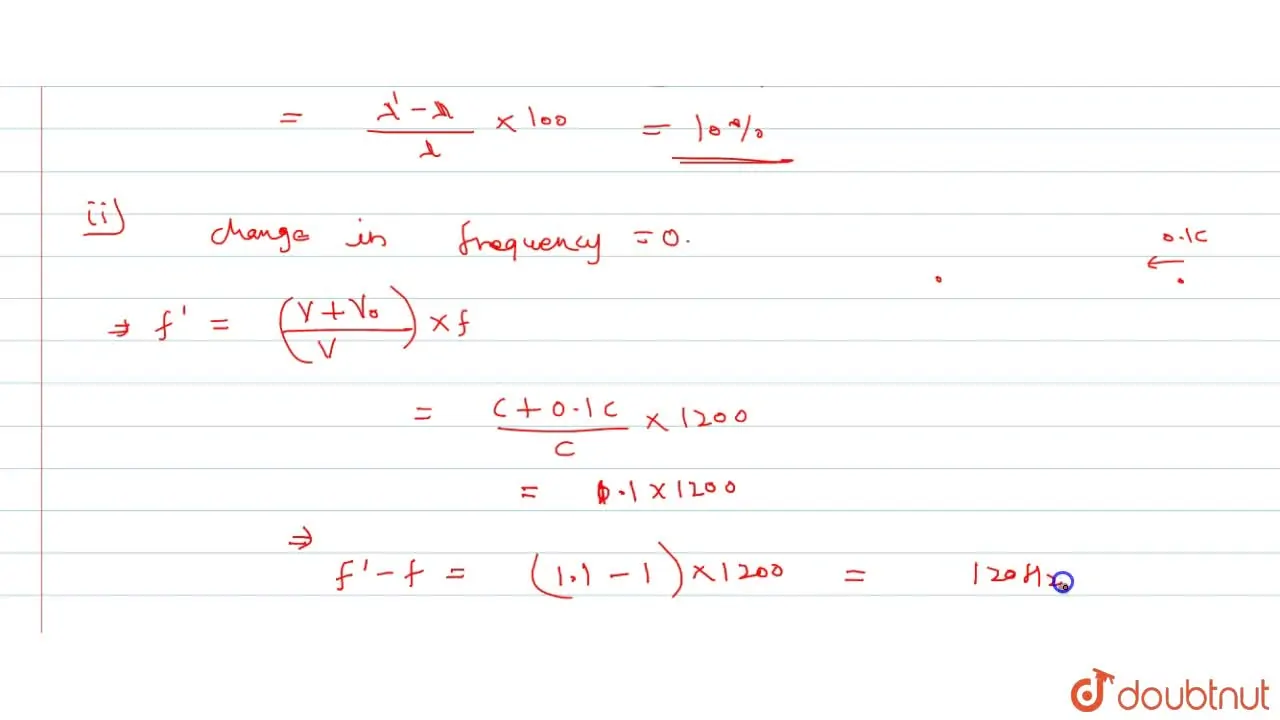A stationary source emits sound of frequency
υ=1200Hz. If a wind blows at the speed of 0.1c deduce (i) the percentage change in the wavelength and (ii) the change in the frequency for a stationary observer on the wind side of the source. What happens when there is no wind, but the observer moves at speed 0.1c towards the source?
If there is no wind n waves emitted by the source in each second will form a train of waves of length equal to speed c of the sound. When the wind blows at speed w, the same number of waves will form a train of length c+w on the windside.
λ'=c+wn=c+wcλ
⇒(λ1−λ)λ=wc
% increase in wavelength
=wc×100=0.1cc×100=0
let n' be the apparent frequency Then n'λ'=c+w (since speed of sound on the wind side is c+w)
or n'=c+wλ'=n
so, there is no change in the frequency of the wave. When the source moves, the wavelength is not changed but the frequency appears to change. The apparent frequency is given by
n'=c−v0c−vS×n
Here vS=0, v0=−0.1c, therefore
n'=c−(−0.1c)c×n=1.1n
% increase=n'−nn×100=10
Related Playlists
- BOOK - CENGAGE PHYSICSCHAPTER - SOUND WAVES AND DOPPLER EFFECTEXERCISE - Subjective56videos
SOUND WAVES AND DOPPLER EFFECT
- BOOK - CENGAGE PHYSICSCHAPTER - SOUND WAVES AND DOPPLER EFFECTEXERCISE - Single Correct252videos
SOUND WAVES AND DOPPLER EFFECT
- BOOK - CENGAGE PHYSICSCHAPTER - SOUND WAVES AND DOPPLER EFFECTEXERCISE - Exercise 6.156videos
SOUND WAVES AND DOPPLER EFFECT
- BOOK - CENGAGE PHYSICSCHAPTER - RIGID BODY DYNAMICS 2EXERCISE - Interger2videos
RIGID BODY DYNAMICS 2
- BOOK - CENGAGE PHYSICSCHAPTER - SUPERPOSITION AND STANDING WAVESEXERCISE - Comprehension Type5videos
SUPERPOSITION AND STANDING WAVES
Similar Questions
A stationary source emits sound of frequency 1200 Hz. If would blows at the speed of 0.1 v. deduce
(a) The change in the frequency for a stationary observer on the wind side of the source
(b) Report the calculations for the case when there is no wind but the observer moves at 0.1 v speed towards the source (Given : velocity of sound = v)View SolutionWhen a source of sound moves towards a stationary observer the pitch of sound will appear to
View SolutionA stationary source produces a note of frequency 1000Hz. An observer in a car moving towards the source measures the frequency of sound as 1057 Hz. Find the speed of the car. What will be the frequency of sound as measured by the observer in the car if the car moves away from the source at the same speed ?
View SolutionA source of frequency 1 kHz is moving towards a stationary observer with velocity of 0.9 times that of sound. What is the frequency heard by the observer ?
View SolutionShow that when the speed of the source and the observer are small compared to the speed of sound in the medium, the change in frequency becomes independent of the fact whether the source is moving or the observer.
View SolutionA source emitting sound of frequency 1000 Hz is moving towards an observer at speed vs=0.90v, (where v is the velocity of sound). What frequency III will be heard by the observer ?
View Solutionwhen a source of sound of frequency f crosses stationary observer with a speed vs(<< speed of sound v) , the apparent change in frequency Dea<af is given by
View SolutionAn observer moves towards a stationary source of sound. The percentage change in the apparent frequency is
View SolutionWhen the source is moving towards the stationary observer, the apparent frequency is given by
View SolutionA source emitting sound of frequency 1000 Hz is moving towards an observer at speed vs=0.90v,(where v is the velocity of sound) . What frequency will be heard by the observer ?
View Solution


